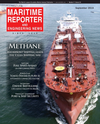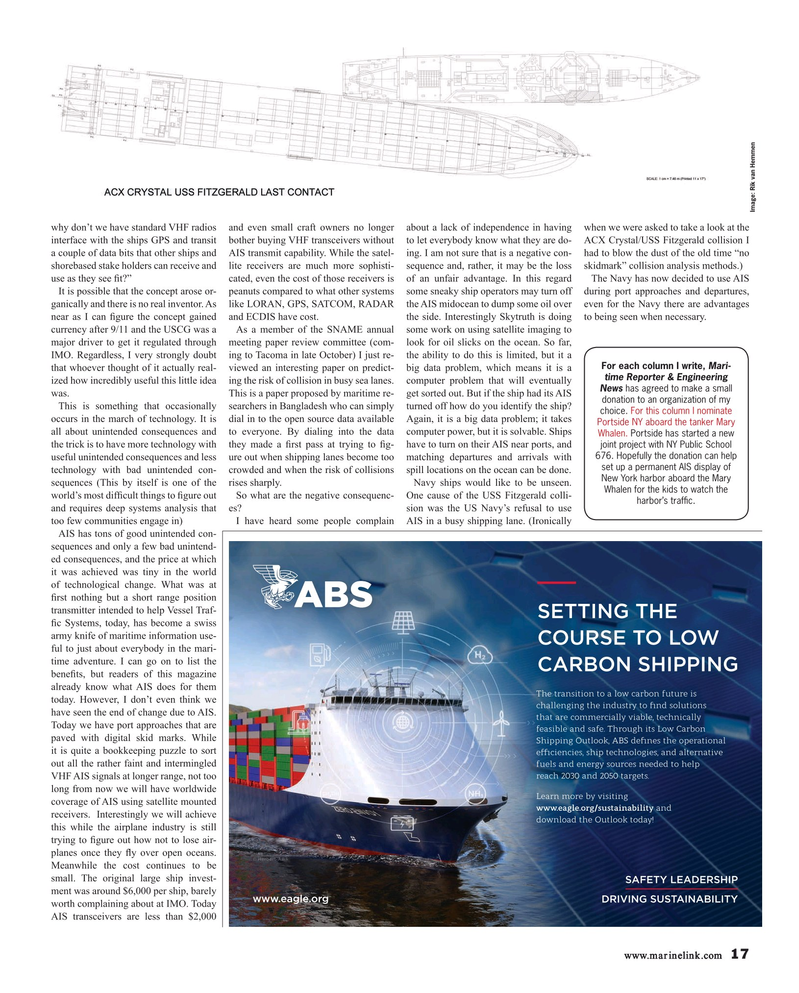
Page 17: of Maritime Reporter Magazine (September 2019)
Satellite Communications
Read this page in Pdf, Flash or Html5 edition of September 2019 Maritime Reporter Magazine
Image: Rik van Hemmen why don’t we have standard VHF radios and even small craft owners no longer about a lack of independence in having when we were asked to take a look at the interface with the ships GPS and transit bother buying VHF transceivers without to let everybody know what they are do- ACX Crystal/USS Fitzgerald collision I a couple of data bits that other ships and AIS transmit capability. While the satel- ing. I am not sure that is a negative con- had to blow the dust of the old time “no shorebased stake holders can receive and lite receivers are much more sophisti- sequence and, rather, it may be the loss skidmark” collision analysis methods.) use as they see ? t?” cated, even the cost of those receivers is of an unfair advantage. In this regard The Navy has now decided to use AIS
It is possible that the concept arose or- peanuts compared to what other systems some sneaky ship operators may turn off during port approaches and departures, ganically and there is no real inventor. As like LORAN, GPS, SATCOM, RADAR the AIS midocean to dump some oil over even for the Navy there are advantages near as I can ? gure the concept gained and ECDIS have cost. the side. Interestingly Skytruth is doing to being seen when necessary.
currency after 9/11 and the USCG was a As a member of the SNAME annual some work on using satellite imaging to major driver to get it regulated through meeting paper review committee (com- look for oil slicks on the ocean. So far,
IMO. Regardless, I very strongly doubt ing to Tacoma in late October) I just re- the ability to do this is limited, but it a
For each column I write, Mari- that whoever thought of it actually real- viewed an interesting paper on predict- big data problem, which means it is a time Reporter & Engineering ized how incredibly useful this little idea ing the risk of collision in busy sea lanes. computer problem that will eventually
News has agreed to make a small was. This is a paper proposed by maritime re- get sorted out. But if the ship had its AIS donation to an organization of my
This is something that occasionally searchers in Bangladesh who can simply turned off how do you identify the ship? choice. For this column I nominate occurs in the march of technology. It is dial in to the open source data available Again, it is a big data problem; it takes
Portside NY aboard the tanker Mary all about unintended consequences and to everyone. By dialing into the data computer power, but it is solvable. Ships
Whalen. Portside has started a new the trick is to have more technology with they made a ? rst pass at trying to ? g- have to turn on their AIS near ports, and joint project with NY Public School 676. Hopefully the donation can help useful unintended consequences and less ure out when shipping lanes become too matching departures and arrivals with set up a permanent AIS display of technology with bad unintended con- crowded and when the risk of collisions spill locations on the ocean can be done.
New York harbor aboard the Mary sequences (This by itself is one of the rises sharply. Navy ships would like to be unseen.
Whalen for the kids to watch the world’s most dif? cult things to ? gure out So what are the negative consequenc- One cause of the USS Fitzgerald colli- harbor’s traf

 16
16

 18
18
